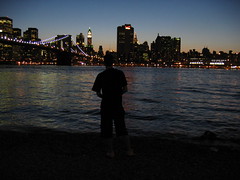
Scorching heat, bright yellow cabs, grey ventilation units, brown rusty fire escapes… welcome to New York.
New Yorkers have a reputation for being unfriendly; rude and brash even. And you know what? It’s total bollocks… or should I say, total bullshit, man. Ten days ago I had my first visit to this legendary city transformed by the warmth and generosity of New Yorkers, in particular by Dub War’s Dave Q, Sekkle and Juakali. This is some of my NYC reflections.
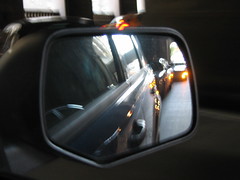
I posted here I was in going to be in the city. It speaks volumes about the place that people then fell over themselves to send me recommendations, guides, ideas and general blasts of enthusiasm about NYC, so much so that like the city itself, even the run up to the trip was a sensory overload. Between a 500 page Rough Guide (useful for knowing what’s what) and about 4000 words of personal recommendations (useful for knowing what’s hot), I felt supremely well prepared for the Big Apple. Honourable mentions must go to Dave Q, Rick Herron and the Dissensus vinyl heads for particularly insightful must-see recommendation guides.
My feelings towards New York have changed over the years. In the mid ‘90s I discovered hip hop, a time of Tribe Called Quest, Wu Tang Clan, Mobb Deep and Gangstarr, a time when many MCs both talked loud and said something. Then came house and garage, with Body & Soul this mythical, enticing place of Afro rhythms and Cuban percussion. Love affairs with other musical cities ran in parallel, through Chicago’s house and Detroit’s techno. Yet come the early 00s and an awakening occurred for me through late UK garage and early dubstep/grime, that made me realise I was surrounded by an amazing city and that if no one was feeding me grand narratives to match those of the US, then I should go out and actively find them myself in London. In the end the New York trip during the NY adoration years never came about while my fever was at it’s peak. Better late than never I suppose.

So here it is, some reflections of New York. Given how photographed, filmed and documented New York is, I don’t think anyone needs me drone on about every last detail, but I can’t help but share some of the best bits of six intense and amazing days. So here are my NYC highlights:
Mad dogs and Englishmen go out in the Brooklyn sun
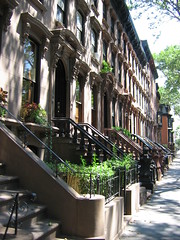
So it’s clear blue day, a baking 40°C. Perfect for a nice stroll? Perfect for an entertaining English schoolboy error. Both Dave and Rick had recommended Williamsburg, Brooklyn. Looking at it on the map, well, it didn’t seem to far from downtown Brooklyn. Why not walk from one to the other, explore a bit? I mean, it’s by the river and everything. So began a compelling but gruelling, two hour trek across a baking hot industrial wasteland.
The wander began in “hipster ground zero” aka the area around Bedford Avenue subway. Think gentle record stores, coffee shops, wine merchants, novelty furniture shops and rough industrial loft-y living that looks cheap and cheerful but apparently isn’t, (cheap that is).
The walk followed south on Bedford Avenue and the boutique stores soon gave way to industrial and residential architecture, though sometimes the divide between the two wasn’t clear. Every country has it’s distinctive building styles and the US is no different. But walking through the 40°C furnace, there was something foreboding about these huge, windowless, airless buildings, air conditioning units poking out like a city-wide art experiment to re-use dead toasters. And these windowless buildings, are they internally darkened to exclude the heat or in fact sealed sweatboxes?
Ducking under the Williamsburg Bridge, the scenery became bleaker, poorer and more industrial. There were few people about, except in one big Project, where kids played in spraying fountains and a Puerto Rican-looking gang took shelter under the tower block eves.
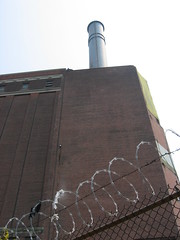
Huge industrial buildings, fenced off by razor wire sat by the river. In the midday heat it was quiet, dead quiet. Sekkle had explained this is where the Mafia roll the bodies out of cars at night and into the East River. I’d remembered he’d said this, except amusingly, I thought he’d meant the other side of Brooklyn (the Jamaica bay side). Oooops.

The area became increasingly Jewish, Nursery school teachers filling a gaggle of kids onto one of the classic American school busses. Broken warehouses were adorned with Hebrew advertising. Dave Q later explained that this is a massive Hasidic Jewish community, possibly the largest outside of Israel. How these guys survive the heat in so much long, black clothing is beyond me.
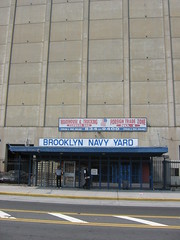
After the Jewish nursery school, flyovers loomed. Then a turn onto Flushing Avenue, came the Navy Boat Yard, all “no trespassing” signs and more airless multi-story brutalism By this point, almost an hour and a half in, the heat was becoming really oppressive. Flushing stretched long into the distance, and the street had an eerie emptiness to it. Signs painted by school children read “Crime Hurts.”
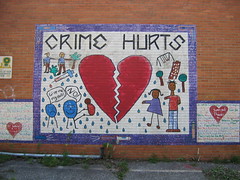
After a long trek down Flushing, decaying buildings grew out of the trees. While you could see they had once been beautiful residential houses behind ornate wrought iron gates, in stark contrast to the naval industrial buildings and gritty warehouse units, they were now in a state of total disrepair, balconies spilling down. Later Dave Q would explain that they were once the Naval Officer’s quarters. Now they face into the Projects.
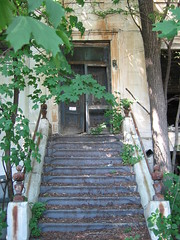

Half an hours’ walk from Flushing leads you to the contrast of Fulton Street, downtown Brooklyn. The borough obviously has a long history of association with hip hop, with Bedford-Stuyvesant to the east and a whole host of hip hop royalty living in Forte Greene. Junior’s, the Brooklyn soul food/cheesecake institution sits at one end. But even in spite of all this, I’d never expected to find a shopping district so damn hip hop it hurt.
If you like trainers bwoy, this one’s you.
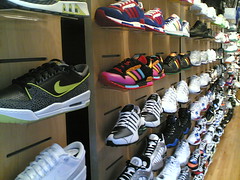
Imagine London’s Oxford Street, from Marble Arch to Tottenham Court Road, where every other shop is like Footlocker for kicks, but better. There were shops that had 20 foot walls of Nu Era caps that they’d personalise for you. It was nuts. With the pound strong against the dollar, shoes are basically half price for UK visitors. Air Max US = $89. Air Max UK = £89. The solution? Buy two pairs.
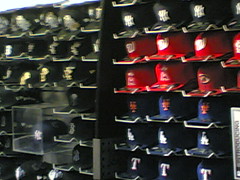
In the stores (and it is “stores” not shops), they blast you with hip hop videos. With the sheer selection of trainers on offer, it was an intoxicating and smothering mix.
Every so often, Common would come on the screens. His great new single intones “you know how we do/we do it for the people” (check the video on YouTube here) Yet with a new album to plug, he’s joined forces with a trainer company for a set of ads based around the theme of “revolution.”
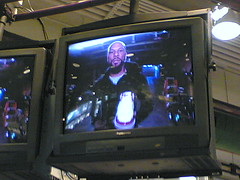
“Make a change…” it said boldly, before continuing, leaning out of the screen, “…buy a shoe.”
Make a change, buy a shoe? How does that help “the people?” How about: make a change, don’t buy a shoe Mr Common?
As Common reached out to the store’s occupants, it was easy to see what a complete and self-reinforcing culture this was. Here’s one of Brooklyn’s most celebrated residents, telling me from fourteen different TV screens in a Brooklyn shoe store, to step into his shoes because it would change the world. On YouTube he told me to buy a T shirt, because that would change the President too.
Intoxicating, smothering, 360 degrees of consumerist rhetoric: I bought some shoes, but not because Common had told me to.
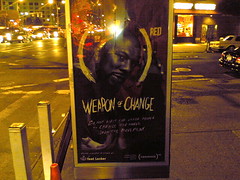
Later in the trip, in the far more ostentatious – yet fitting – surroundings of the Marriot Hotel Times Square’s rotating bar, I got into the usual discussions with an American friend about UK v US culture, while being served by an over friendly waiter who insisted we use his first name (“OK Damon, nice to meet you too Damon…”). Recently returned from working in the UK, my friend raised an oft-heard gripe about the UK but took it further. Service in the UK is shit, he insisted. Service is expensive, fake and unfair in the US, I returned.
In the UK waiters or bar staff are guaranteed a minimum salary. This is fairer because regardless of customer whim, they get a steady, predictable income. Furthermore they don’t act like your new best friend because realistically, they don’t know you – and for British people, that that’s fine. The situation in the US is that you tip many people in the service sector (don’t ask me exactly which, it’s still a mystery) around 18%. This creates an incentive for the server to give good service and makes the customer feel satisfied. More spending from the customer drives consumer business. And consumer spending is the driver for the global economy, because without it, he continued, there’d be no business-to-business economy and then we’d all be unemployed. Ergo the woman who greets you in the shop doorway is the front person for the entire global economy. Have a nice day.
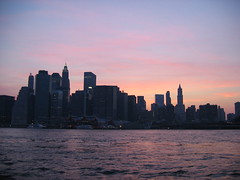
The Marriot, Times Square, 6th avenue, Macy’s (1 store = 1 billion square feet), the food portions, the 5XL t-shirts in Brooklyn (like tents), the sky scrapers: everything’s so large and glittering here – and like the Common-endorsed trainer-walls of Fulton Street, it’s intoxicating. This emphasis of consumption and capitalism as the central pillars of society seem to be such a defining US trait. American have such a positive, can-do, anyone-can-be-President (especially if they’re vastly wealthy) attitude which you do have to admire. And, as the richest country in the world, their successes speak for themselves.
But personally, I just feel uncomfortable making such a central emphasis on capitalism. I wonder, what’s truly important: how rich we are? Or is it what we think, what we believe, whether we’re fair and inclusive? There might be, in theory, equal opportunity for anyone to become rich, but in practice the rich tend to get richer and the poor, poorer. Times Square gets brighter, the Projects of Flushing, Brooklyn get poorer. Nike rewards it’s shareholders, child labour in an Export Processing Zone gets exploited. And I can’t accept it’s that poor people don’t work hard enough (one unpleasant argument I heard this trip), it simply has to be that the playing field of opportunity (educational, health, financial…) isn’t equal, and that to me is an inequality that should be fought against. Have a nice day y’all – and I do mean all.
Sekkle’s Sights
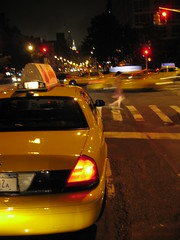
A paradox of Manhattan is that while it’s big in wealth, aspiration and vertical skyscraper ascent, along the ground it’s actually not that wide. As a consequence, exploring the various patchwork neighbourhoods that make up Manhattan is easy by foot – far easier than my foolish attempts to walk across a “small” town in California.
Another paradox that becomes apparent to visitors is that while the city has a reputation of being shiny and new, there’s far more sense of history embedded in the buildings that outsiders might initially anticipate. This became clear during two wonderful days spent exploring with NYC enthusiast and closet historian, Sekkle, of Dub War and Dubstep Forum fame.
The first journey began on Wednesday eve. We’d planned to see Femi Kuti and band in Central Park – how sick would that have been? – but despite the week’s 38°C heat wave, the heaven’s opened. We had to shelter from the Monsoon in the Apple store which, with stairs descending from the ceiling, resembles the glass structure in the Louvre. And damn the iPhone’s a good look – Dave Q’s bagged one. Cos he’s got it like that.
Instead of Femi we headed to SoHo for Thai food and when the rains had passed, we began wandering. Essentially we walked in a big circuit, taking in SoHo, the West Village, Greenwich Village and Astor Place. We had a pint in a sports bar (Argentina were tonking someone in the Copa America), saw tiles painted by school kids for 9-11 victims and came across Love – the new Dubwar Venue that has a soundsystem to fully rival Plastic People and 3rd Base I’m told. Next to Love is Hendrix’s Electric Ladyland studios and beyond that the park he used to jam in during session breaks.
One definite highlight was the KGB bar that Sekkle lead us to. According to Sekkle, the venue used to be the home of the KGB during the McCarthy/Cold War era but masqueraded as an arts venue. These days it’s an enjoyably low-lit, grimey venue, with hip hop dudes eating fried chicken at tables next to the arts crowd. Naturally the venue’s red, with posters of Lenin above the vodka collection. The barman sounded American-Chinese (China: last true stronghold of communism?) and it only added to the atmosphere of the venue that Sekkle wouldn’t let me take photos.
But the evening’s real highlight was the beautiful Brownstones of the Greenwich and the West Village. While you always knew you were in New York – the stairs and dark stone never let you forget – with the old trees and quiet ambiance, there were definite parallels with London, old west London. Sekkle himself was a wealth of information about the differing buildings, pointing out ship-style windows, restorations or classic examples of architecture built next to cheap newer alternatives.
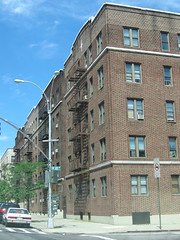
This amazing insight into the city continued the next day, when Sekkle Sights led us uptown, north of Central Park and into Harlem. With the benefit of two essential assets: local knowledge and a car, Sekkle’s offer of a trip through the historic black centre of Harlem was much appreciated. Harlem essentially covers the north tip of Manhattan. Columbia University is situated there and the immediate surroundings to the campus are gentrified and safe, but the reality is that while daytime is fine, as a white visitor, trips on foot in Harlem by night are not advised. I’d simply stand out.
Rolling in Sekkle’s car, we were listening to an old but special Rinse set: Kode9 b2b Mala b2b Joe Nice (shoes off), Orson inside. It was summer 2005 but already it feels like a long time ago, sonically at least. Then, as we hit the top of Harlem, who should call but Joe on his way to DMZ. There was some hollering in the car, I can tell ya.
A few days later, after we’d walked near some of the Projects off Flushing Avenue, Brooklyn, one of Dave Q’s mates questioned what the interest in places like these is. It’s a fair question and one I’d been asking myself while rolling through Harlem with Sekkle.
The answer comes in several parts. Firstly, there’s the buzz of exploring, of going where I really don’t belong. Secondly for anyone raised on hip hop from an early age, their minds are flooded with these grand narratives made from location-based identity. “Where’s Brooklyn at?” “The South, South Bronx…” “Strong Island!” “Bedford Stuyvesant.” Sugarhill, Harlem. Hook after hook sticks in your mind, so much so that you feel compelled to see some of these places. And finally it feels important to acknowledge that New York is not just Macy’s and Manhattan, that there are other lives and other ways of living beyond the glitz and glamour of affluent downtown.
All that said, by day and by car, Harlem was deceptively quiet. The only way to tell that a given road was a crime hotspot or drive by shooting location, was the density of CCTV cameras, two per door, on every door in a given street, to monitor the drug dealers, explained Sekkle. Despite America’s reputation for segregation, Harlem had that jumbled proximity quality, where in three streets you could go from des-res to do-not-enter, without much visual change in the surroundings.
The surroundings in Harlem were at times very beautiful, row after row of Brownstones. Other blocks were imposing and physical, chunkier than many London buildings. We also passed the Audubon Ballroom where Malcolm X was assassinated, the mosque where he practiced and the boulevard that’s now named after him. Sekkle’s sights then looped us over the bridge and into the South Bronx for a few moments, passing the once legendary jazz Cotton Club and Yankee Stadium, before we headed off to eat.
MoMA
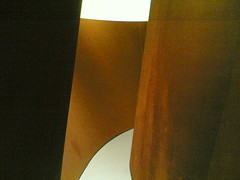
Another unexpected highlight was the Museum of Modern Art (MoMA). Museums of this weight are foolish to try and tackle in one attempt, so we picked our point of attack.
En route you can’t miss the drawing on the four-storey wall by Romanian artist Dan Perjovschi. MoMa has YouTube links of him drawing them here. People were dotted around this space, just stopped wherever they were when they noticed the drawings. Each is simple but cheekily political, a comment-puzzle on current living that invites the brain to decipher it. There’s a great photo on Flickr here
Next we headed into the Richard Serra exhibition, as recommended by Rick Herron. Serra’s most impressive work in this exhibition is a series of massive, curved, sculptures. Built from rusty sheet steel and folded gracefully into 20 foot or so high, meandering abstract structures, you are at liberty to wander between and around them, the curves engulfing you and then spitting you out.

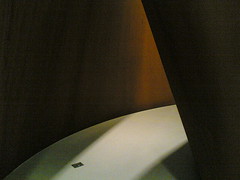
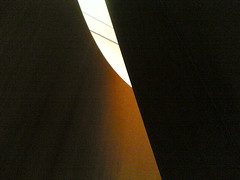
The exhibition notes talk of the work “engaging with memory – with the inevitable inability of the viewer to construct any distinct memory of these almost indistinguishable and ever-changing spaces.” Yet my impressions were instead of a sense of majestic rhythm mixed with a playful joy. Close inspection of the rusty steel revealed marks from running water, which made me question the artists’ intent. Were all the marks on the steel as the artist had intended, was decay and weathering part of his message, or were these random defects incurred post-construction?
We wandered up to the photography floor. A few rooms clustered disparate black and white photographs together, including Cartier-Bresson’s famous Behind the Gare St. Lazare, Paris. Most amusingly, amid all the black and white American shots, was a photograph of Croydon airport, circa 1920. A dubstep head goes half way around the world and enters the best modern art gallery in town, and what does he see? There’s no escaping Croydon ;-)
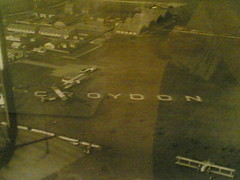
I’d bumped into Loefah in the street in central London a few days before I’d flown out, and it had reminded me of something he’d said in our interview about how photographed NYC was, how iconic it seemed, especially to music fans who’ve grown up with it as a backdrop to the music of their youth, and how familiar that made the city feel at regular places. Now I was in NYC myself, looking at iconic imagery of Loefah’s south London…
The other highlight of this floor was the Barry Frydlender. In contrast to the small, black and white shots of previous rooms, Frydlender delighted in massive, colour panoramas that ostensibly told the tale of everyday life for Israelis and Palestinians. What made the shots to absorbing was the level of detail visible at this size. Closer inspection drew you in until you realised that many of the characters in the shot appeared twice, if not more. Israeli soldiers, armed to the teeth with M16 assault rifles and dogs, raided militants’ homes: when you noticed one of them staring right back at you, it stopped you dead. Other panoramas depicted Arab revellers of an evening, settlers being removed or heavily-dressed orthodox Jews at hot, outdoor ceremony.
The museum’s final highlight that we encountered was a room that not only hung Picasso’s Les Demoiselles d'Avignon, but twenty or so preparatory sketches and paintings, many of which revealed quite different discarded features, such as men amongst the prostitutes for example. The influence of African tribal masks was quite apparent. After gliding past some of Monet’s soothing water lilies (MoMA is a bit like Now That’s What I Call Modern Art in places), it was time to leave.
The Met Museum wasn’t a priority on the New York agenda, but stumbling across the armoury on a hot day was a welcome break. Armour’s never been a huge fascination of mine, probably because of its use for killing and warfare, but the Japanese swords and Arabic scimitars were breathtaking. The Japanese armour is hilariously shaped, with evil faces and shaggy beards built in. Their master sword makers fold their steel hundreds of times and the blades remain elegant, centuries later. Arabic swords were mostly used in rituals, one that took precedent over the coronation: the Met has one scimitar who’s owner went insane between becoming the ruler and having is ceremony. Unfortunate.
Record shop worth shouting about: A1, Manhattan:

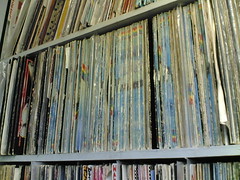
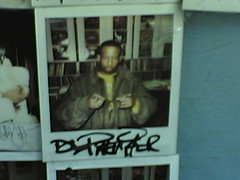
Yes, that’s Premier in the signed Polaroid. How many Salsoul 12”s is that?
Records/CDs bought
· The Watts Prophets “Rappin’ Black in a White World” (Ala records)
· “Music of Iran vol 3: Santur Recital” (Lyrichord)
· “Caravan: Melodies of the Middle East” (Orient Record Co)
· Shanung “Music of Confucius’ Homeland” (Lyrichord)
· Aaliyah “One In A Million (LP promo)” (Be)
· Aaliyah “Age Ain’t Nothing But a Number” (Jive)
· Dr Martin Luther King Jr “Memorial Album: New Wine in Old Bottles” (Napamy)
· Pandit Pran Nath “Raga Cycle Palace Theatre Paris 1972”(Sri Moonshine CD)
· Konono N°1 “Congotronics” (Crammed CD)
Other highlights:
· Lower East Side: probably my favourite part of Manhattan. Funky, run down, cool. We wandered into Hamilton Fish Park lido. If it had been 38°C in my estate and I was 12, I’d have been in that pool too.
· DUMBO: walk over Brooklyn Bridge at sunset, only look back at the midpoint. The head left to the riverside park nestled under Manhattan bridge. Views to die for
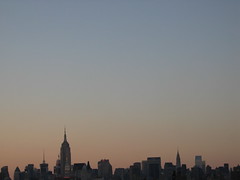
· Tubes that are air conditioned: how fucking civilized?
· Passing famous landmarks: “oh, there’s The Blue Note”
· Meeting Hank Shocklee of Bomb Squad fame. He’s making a dubstep album…
· Ron Trent at the glittery Deep Space nice. Sweeet soundsystem

· The Pickle Guys and Essex Street market, Lower East Side
· Grimaldi’s Pizza’s, DUMBO
· The Nuclear Bunker signs on Harlem and Brooklyn houses
Had to grab a shot of this…
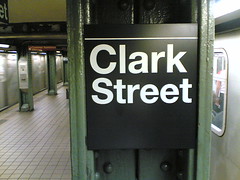
The “for next visit” list
· VP Records, Queens
· Arthur Kills Boat Yard, Staten Island
· Dub War@Love
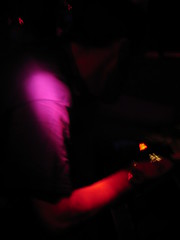
Dave Q on the decks
12 comments:
Shanung “Music of Confucius’ Homeland” (Lyrichord)
Boom!
I think Lyrichord are about to become a new Tempa/Impulse/Blue Note/Ghost to me... a must-buy. Their releases are nuts! Any other Lyrichord recommendations?
Good read. Interesting to see a British perspective on the city.
great read as ever, just one minor oversight - common's from chicago, not brooklyn ;)
Yeah I know, but Dave Q assured me he's resident in Brookyln, is that possible?
This post definitely resonated with me. Ive been infatuated with NYC and the 5 boroughs since a mere yoot. Never had the chance to reach there though. I always presumed there was a real magic about the place because thats where all my heroes were. Nas, Melle Mel, KRS One, Jay, Mobb Deep, Wu Tang. etc.
Great read Mr. Blackdown. And you know that you're always welcome for a return trip. I think we'll need a signed polaroid from you soon!!! Big it!! Seckle :)
Haha, yeah yeah Mr Sekkle, when I get a Polaroid in A1s, you'll have the keys to the city!
common must have an apt in brklyn. you run into him all the time in the fort green area.
seckle.
also, A1 records isn't online or in your tour books. it's the cratediggers spot and they make themselves very hard to find for a reason.
A1 records, 6th Street between Ave A and 1st ave.
big up ,
seckle
I keep meaning to get down to photograph the Dubwar nights over in NYC but ain't made it yet. looks like I'll be checking your blog for the latest Dubstep news though, don't half miss London Town.
Ah, VP Records... My dad used to master all his albums over there...
Hello. And Bye.
Post a Comment